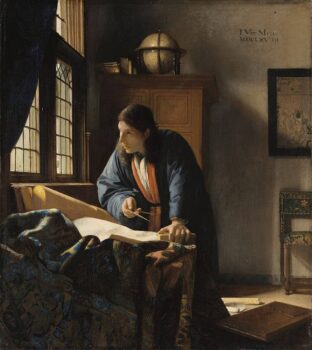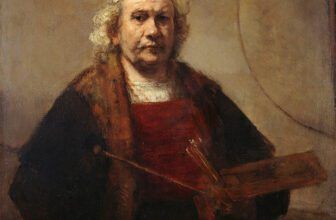Vermeer’s The Geographer and the Global Imagination Analysis and Meaning
Few works of art capture the harmony between science, philosophy, and the human spirit as beautifully as Johannes Vermeer’s The Geographer, painted around 1668–1669 during the Dutch Golden Age. Though relatively modest in size, this painting has generated centuries of admiration, debate, and scholarly analysis. It is both a work of striking technical mastery and an enigmatic image that invites questions about exploration, knowledge, and human curiosity.
In this comprehensive analysis, we will examine the painting in detail, exploring its composition, symbolism, meaning, historical context, controversies, and significance. We will also consider the type of art it represents, the circumstances of its creation, and where the painting resides today.
Johannes Vermeer (1632–1675), a painter from Delft, is celebrated as one of the great masters of the Dutch Golden Age. This was a period when the Netherlands flourished economically, scientifically, and artistically. The mid-17th century was marked by trade, navigation, and the expansion of knowledge, thanks to the Dutch Republic’s role as a maritime power.
Vermeer, though not prolific (he left behind only about 34 known works), was a painter of extraordinary skill in light, perspective, and quiet psychological depth. His paintings often depicted domestic interiors, with women engaged in everyday activities. The Geographer, however, stands out as one of his few works centered on a male figure, and one deeply connected to science and exploration.
It was painted at a time when scientific inquiry and global navigation were reshaping European worldviews, making the subject especially relevant to Vermeer’s contemporaries.
The Geographer depicts a single man, dressed in a Japanese kimono-style gown, leaning forward with an expression of intensity and purpose. He is in a richly lit study, surrounded by instruments of measurement and maps. His left hand grips a divider (compass), poised above a globe. His right hand rests on the table, holding down papers, as if in the midst of a breakthrough or decision.
The light pours in through a window on the left, illuminating the scholar’s face and the objects around him. Books, rolled maps, and navigational tools are scattered across the desk, suggesting intellectual activity.
The man appears in motion, caught in a dynamic moment of thought and discovery, very unusual for Vermeer, whose figures are often serene, still, and contemplative. This gives The Geographer a sense of vitality that distinguishes it from much of his oeuvre.
Who Painted The Geographer and How It Was Made
Johannes Vermeer created The Geographer in Delft, using oil on canvas. The painting measures approximately 53 × 46.6 cm (20.9 × 18.3 in).
The model is widely believed to have been Antoni van Leeuwenhoek, the famed scientist and inventor of the microscope, who lived in Delft at the same time as Vermeer. Both were about the same age, and both shared a fascination with optics and observation. Leeuwenhoek later served as executor of Vermeer’s estate after his death, suggesting a personal connection. While this identification cannot be proven, it is supported by strong circumstantial evidence.
Vermeer, known for his painstaking process, likely used a camera obscura, a device that projected a real-world scene onto a flat surface, allowing him to study light and perspective with remarkable precision. His brushwork in this painting demonstrates his mastery of texture, silks, paper, wood, and even the crisp highlights of the dividers gleam with realism.
What Is The Geographer About?
At its core, The Geographer is about the pursuit of knowledge. It captures a moment of intellectual discovery, an allegory of human curiosity and the desire to understand the world.
The figure, absorbed in his work, represents not only a scientist or cartographer but also the broader human condition of seeking order and meaning in the universe. The globe, maps, and tools emphasize humanity’s quest to measure, chart, and ultimately master the natural world.
More specifically, the painting reflects the 17th-century fascination with navigation and geography. The Dutch Republic’s success as a maritime power relied on precise maps and instruments. Vermeer’s painting thus symbolizes not only science but also national identity and pride in Dutch achievements.
Symbolism and Meaning of The Geographer
Every element in the painting contributes to a web of symbolism:
The Dividers (Compass)
The tool in the geographer’s hand symbolizes precision, measurement, and rational inquiry. It represents humankind’s ability to impose order on the natural world through science.
The Globe
The globe suggests global exploration, trade, and the expanding horizons of the Dutch Republic. It reminds the viewer of the age of discovery and the interconnectedness of distant lands.
Maps and Charts
Rolled maps and charts strewn about symbolize accumulated human knowledge and the practical application of geography to navigation and commerce.
The Window and Light
Vermeer’s signature use of light carries symbolic weight. The bright natural light entering from the left suggests enlightenment, divine inspiration, or the illumination of truth.
The Kimono-Like Robe
The gown, imported through Dutch trade with Asia, indicates global connections and the influence of foreign cultures. It also reflects the dignity and intellectual status of the scholar.
Dynamic Pose
Unlike Vermeer’s serene female figures, the geographer leans forward, caught in thought. This symbolizes human activity, the restless search for answers, and the excitement of discovery.
What Is Happening in the Painting?
The painting captures a moment of mental engagement. The geographer appears to have paused mid-calculation, as if struck by a new idea or on the verge of a discovery. His hand grips the divider with intensity, while his gaze looks slightly upward, suggesting inspiration.
This moment of pause, between action and realization, creates drama. Vermeer portrays not just the outward appearance of a scholar at work but the inner life of thought itself. The viewer feels as though they are witnessing the very birth of knowledge.
Why Is The Geographer Controversial?
The controversy around The Geographer is subtle but persistent, centering on several questions:
Identity of the Model
Was the geographer truly Antoni van Leeuwenhoek, or just a generic scholar? The uncertainty fuels debate, as confirmation would link two of Delft’s greatest figures, Vermeer the painter and Leeuwenhoek the scientist.
Companion Painting (The Astronomer)
Scholars debate whether The Geographer was intended as a pair with Vermeer’s The Astronomer. Both paintings depict male scholars with scientific tools, similar dimensions, and a dynamic sense of thought. If paired, they represent two sides of human inquiry: earthly (geography) and celestial (astronomy). Some argue they were commissioned together, while others see them as separate works.
Interpretation of Symbolism
Is the painting a literal depiction of a scientist at work, or an allegory for human ambition and divine illumination? Some see it as celebrating rationalism, while others believe it critiques human pride in mastering the world.
Ownership and Attribution
Like many Vermeers, the painting’s attribution was questioned in earlier centuries, before Vermeer’s reputation was fully restored in the 19th century. Today, it is firmly accepted as his, but debates over provenance contributed to its controversial history.
The Type of Art The Geographer Represents
The Geographer is an example of Dutch Golden Age painting, specifically genre painting, a scene from everyday life. However, it also functions as a history painting in disguise, since it conveys profound symbolic meaning rather than a literal snapshot of daily activity.
The painting embodies Vermeer’s unique style:
Mastery of light (subtle gradients and natural illumination).
Quiet intensity (a balance between calm atmosphere and intellectual drama).
Realism infused with symbolism, making it both a genre scene and an allegorical portrait.
It also reflects the influence of scientific revolution art, where knowledge, instruments, and inquiry became worthy subjects.
Where Is The Geographer Today?
The Geographer resides in the Städel Museum in Frankfurt, Germany. It entered the museum’s collection in the 19th century and remains one of its most prized holdings. Visitors from around the world come to admire the painting, drawn by its luminous quality and enigmatic subject.
Its presence in Frankfurt, rather than Delft or Amsterdam, adds an international dimension to its story, much like the global horizons it depicts.
Legacy and Impact of The Geographer
The Geographer remains one of Vermeer’s most celebrated works because it speaks to timeless human concerns. In its quiet way, it captures:
The pursuit of knowledge, the eternal drive to understand our world.
The spirit of exploration, both physical (geography, navigation) and intellectual (science, philosophy).
The Dutch Golden Age mindset, where trade, science, and art were interwoven into national identity.
A bridge between art and science, making it resonate with historians, scientists, and artists alike.
The painting also continues to spark new interpretations. Some see the figure as a symbol of modern man’s restless search for meaning; others as a celebration of Dutch innovation. Its ambiguity keeps it alive in the scholarly imagination.
Johannes Vermeer’s The Geographer is more than just an image of a scholar at work. It is a meditation on curiosity, knowledge, and human endeavor. Through light, gesture, and carefully chosen objects, Vermeer created a timeless allegory of intellectual discovery.
Its controversies, over the model, its pairing with The Astronomer, and its deeper meaning, only enhance its allure. Today, it stands as a testament to Vermeer’s genius and to the Dutch Golden Age’s passion for science and exploration.
For modern viewers, The Geographer remains a profound reminder of what it means to seek truth in a complex world: the act of leaning forward, compass in hand, eyes lit with the excitement of discovery.




